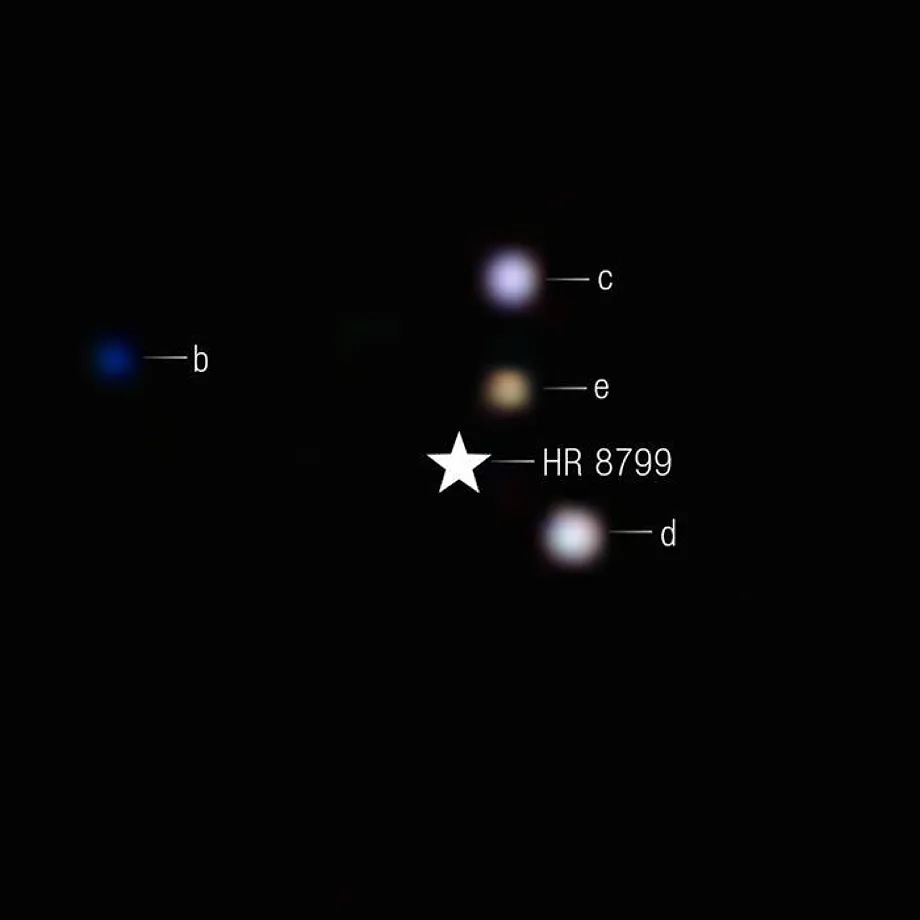Outside our solar system, about 130 light-years away, there is a planetary system that has long been the target of astronomers studying how other worlds were formed. It orbits the star HR 8799 and is composed of four planets. Now, the James Webb (JWST), the most powerful space telescope, has captured images of carbon dioxide (CO2) present on these worlds. These are the first images of carbon dioxide outside our solar system captured by this telescope launched on December 25, 2021, as detailed in a study published this Monday in the journal The Astrophysical Journal.
HR 8799, composed of four planets, is a young solar system, estimated to be about 30 million years old, compared to our 4.6 billion years. As they are still hot from their violent and recent birth, these worlds emit large amounts of infrared light that provide valuable data to scientists about their formation process.
What does the detection of carbon dioxide in this system mean? "We have observed giant gas planets, such as Jupiter or Saturn, but in another solar system," summarizes William Balmer, researcher at Johns Hopkins University in the US and lead author of the study. "Since these planets are very massive and mostly gaseous, they have swollen atmospheres composed of many different types of molecules. One of the molecules that can naturally be found in the atmospheres of giant gas planets is CO2. In a large gaseous atmosphere, CO2 is naturally produced by chemical reactions between water (H2O), carbon monoxide (CO), and hydrogen gas (H2)."
Giant planets can form in two ways: slowly building solid cores that attract gas, like our solar system, or rapidly collapsing from the cooling disk of a young star to become massive objects. Knowing which model is more common can give scientists clues to distinguish between the types of planets found in other systems.
One of the obstacles is that so far, very few direct images of exoplanets have been obtained, as they are thousands of times fainter than their stars. By capturing direct images at specific wavelengths only accessible with the James Webb, this team of astronomers is paving the way for more detailed observations to determine if the objects they see orbiting other stars are truly giant planets or another type of objects, such as brown dwarfs, which form like stars but do not accumulate enough mass to initiate nuclear fusion.
In addition to providing solid evidence that the four planets comprising the HR 8799 system formed similarly to Jupiter and Saturn - gradually building their solid cores - this detection also confirms that the Webb is capable of directly analyzing the chemistry of exoplanet atmospheres, not just inferring the composition from measurements of starlight.
"We did not expect these planets to have much carbon dioxide, because for decades, astronomers thought they could be composed almost entirely of hydrogen and helium," says William Balmer via email. "The fact that these planets show such intense CO2 signals indicates that they were originally formed from ice and rock 'planetesimals' cores, which had a large amount of CO2 ice. Then, these cores grew large enough to collect a large amount of hydrogen gas," he explains. This is how they believe the giant gas planets in our solar system, Jupiter and Saturn, were formed.
Search for life on exoplanets
Asked if any of these planets could harbor life, he assures that "unfortunately" there are no possibilities for that: "These are abiotic carbon dioxide molecules produced by simple chemical reactions in atmospheres of very high pressure," he reiterates.
However, he adds another possibility: "It is possible that there are smaller rocky planets in these solar systems that we cannot see yet, or rocky moons (like Europa around Jupiter, or Titan around Saturn) that could have atmospheres or oceans that could harbor life. But for now, they are pure speculations, although I love science fiction," he says.
In that sense, he anticipates, "scientists hope to build in the future a space telescope capable of searching for life signals on rocky planets, using the same technique we have demonstrated here (direct imaging of planets with a coronagraph). Hopefully, the next generation of scientists will be able to make more solid claims about life on exoplanets."
Returning to the present, Balmer states that they expect to find more elements like CO2 outside our Solar System thanks to the James Webb: "Other teams have made more observations of this system with this telescope, and they are likely to discover even more interesting elements and molecules. Of particular interest are elements like phosphorus (P) and sulfur (S), which should give us more information about the rocks that formed these planets, as our observations have provided us with a lot of information about ice."
Likewise, his team has obtained an additional 20 hours of observation time on the JWST to replicate this same CO2 experiment in four other solar systems in 2026, "to see if this system, HR 8799, is an atypical case or not," he details.
With these types of investigations, Balmer summarizes, what they aim for is "to understand our own solar system, life, and ourselves in comparison to other systems in order to contextualize our existence," says Balmer. "We want to take pictures of other solar systems and see how they resemble or differ from ours. From there, we can try to get an idea of how rare our solar system really is... or how normal."
